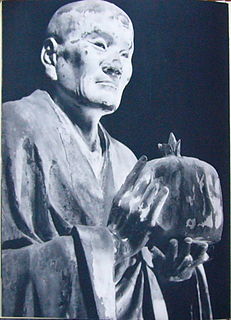
Asaṅga was "one of the most important spiritual figures" of Mahayana Buddhism and the "founder of the Yogachara school". He is known as one of the seventeen Nalanda masters and taught at the monastery which is located in modern-day Bihar. Traditionally, he and his half-brother Vasubandhu are regarded as the major classical Indian Sanskrit exponents of Mahayana Abhidharma, Vijñanavada ) thought and Mahayana teachings on the bodhisattva path.

Ravana was a demon king of the island Lanka and the chief antagonist in the Hindu epic Ramayana and its adaptations.

Kubera also known as Kuvera, Kuber or Kuberan, is the god of wealth and the god-king of the semi-divine Yakshas in Hindu culture. He is regarded as the regent of the North (Dik-pala), and a protector of the world (Lokapala). His many epithets extol him as the overlord of numerous semi-divine species and the owner of the treasures of the world. Kubera is often depicted with a plump body, adorned with jewels, and carrying a money-pot and a club.
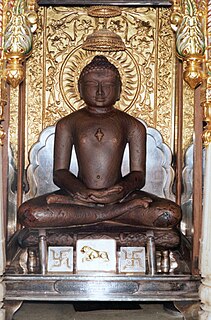
Mahavira, also known as Vardhamana was the 24th Tirthankara of Jainism. He was the spiritual successor of the 23rd Tirthankara Parshvanatha. Mahavira was born in the early part of the 6th century BCE into a royal Jain family in Bihar, India. His mother's name was Trishala and his father's name was Siddhartha. They were lay devotees of Parshvanatha. Mahavira abandoned all worldly possessions at the age of about 30 and left home in pursuit of spiritual awakening, becoming an ascetic. Mahavira practiced intense meditation and severe austerities for 12 and a half years, after which he attained Kevala Gyan (omniscience). He preached for 30 years and attained Moksha (salvation) in the 6th century BCE, although the year varies by sect.

Bhaiṣajyaguru, or Bhaishajyaguru, formally Bhaiṣajya-guru-vaiḍūrya-prabhā-rāja, is the Buddha of healing and medicine in Mahāyāna Buddhism. Commonly referred to as the "Medicine Buddha", he is described as a doctor who cures suffering using the medicine of his teachings.

In Buddhism, wrathful deities or fierce deities are the fierce, wrathful or forceful forms of enlightened Buddhas, Bodhisattvas or Devas. Because of their power to destroy the obstacles to enlightenment, they are also termed krodha-vighnantaka, "Wrathful onlookers on destroying obstacles". Wrathful deities are a notable feature of the iconography of Mahayana and Vajrayana Buddhism. These types of deities first appeared in India during the late 6th century with its main source being the Yaksha imagery and became a central feature of Indian Tantric Buddhism by the late 10th or early 11th century.
Buddhism includes a wide array of divine beings that are venerated in various ritual and popular contexts. Initially they included mainly Indian figures such as devas, asuras and yakshas, but later came to include other Asian spirits and local gods. They range from enlightened Buddhas to regional spirits adopted by Buddhists or practiced on the margins of the religion. Notably, Buddhism lacks a supreme creator deity.

The yakshas are a broad class of nature-spirits, usually benevolent, but sometimes mischievous or capricious, connected with water, fertility, trees, the forest, treasure and wilderness. They appear in Hindu, Jain and Buddhist texts, as well as ancient and medieval era temples of South Asia and Southeast Asia as guardian deities. The feminine form of the word is yakṣī or yakshini.

Yakshinis a class of nature spirits in Hindu, Buddhist, and Jain religious mythologies that are different from devas (gods), asuras (demons), and gandharvas or apsaras. Yakshinis and their male counterparts, the yakshas, are one of the many paranormal beings associated with the centuries-old sacred groves of India.
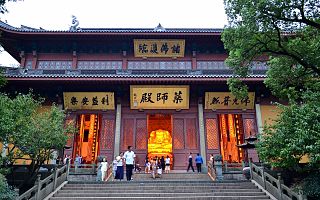
Lingyin Temple is a Buddhist temple of the Chan sect located north-west of Hangzhou, Zhejiang Province, China. The temple's name is commonly literally translated as Temple of the Soul's Retreat. It is one of the largest and wealthiest Buddhist temples in China, and contains numerous pagodas and Buddhist grottoes.

Parshvanatha, also known as Parshva and Paras, was the 23rd of 24 Tirthankaras of Jainism. He is the only Tirthankara who gained the title of Kalīkālkalpataru.

Government Museum, Mathura commonly referred as Mathura museum is an archaeological museum in Mathura city of Uttar Pradesh state in India. The museum was founded by then collector of the Mathura district, Sir F. S. Growse in 1874. Initially it was known as Curzon Museum of Archaeology, then Archaeology Museum, Mathura, and finally changed to the Government Museum, Mathura.
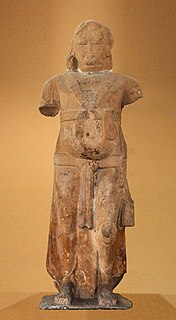
Manibhadra is one of the major yakshas. He was a popular deity in ancient India.

The Northern Satraps, or sometimes Satraps of Mathura, or Northern Sakas, are a dynasty of Indo-Scythian rulers who held sway over the area of Eastern Punjab and Mathura after the decline of the Indo-Greeks, from the end of the 1st century BCE to the 2nd century CE. They are called "Northern Satraps" in modern historiography to differentiate them from the "Western Satraps", who ruled in Gujarat and Malwa at roughly the same time and until the 4th century CE. They are thought to have replaced the last of the Indo-Greek kings in the Eastern Punjab, as well as the Mitra dynasty and the Datta dynasty of local Indian rulers in Mathura.

The Art of Mathura refers to a particular school of Indian art, almost entirely surviving in the form of sculpture, starting in the 2nd century BCE, which centered on the city of Mathura, in central northern India, during a period in which Buddhism, Jainism together with Hinduism flourished in India. Mathura "was the first artistic center to produce devotional icons for all the three faiths", and the pre-eminent center of religious artistic expression in India at least until the Gupta period, and was influential throughout the sub-continent.

Paradise of Bhaisajyaguru (薬師佛) or Pure Land of Bhaisajyaguru is a painting during China’s Yuan Dynasty. This painting was originally housed in Guangsheng Lower Monastery, Zhaocheng County, Shanxi. The painting, which was at the eastern gable wall of the Main Hall of the monastery, was purchased by Arthur M. Sackler and later was given to Metropolitan Museum of Art, New York, United States in 1954.
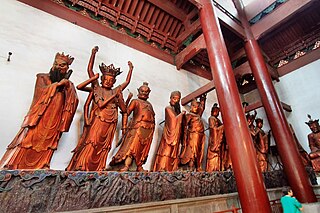
The Twenty-Four Protective Deities or the Twenty-Four Devas, sometimes reduced to the Twenty Protective Deities or the Twenty Devas, are a group of dharmapalas in Chinese Buddhism who are venerated as defenders of the Buddhist dharma. The group consists of devas, naga kings, vajra-holders and other beings, mostly borrowed from Hinduism with some borrowed from Taoism.